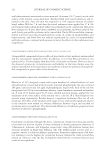ALKALOIDS IN COSMETICS 239 diseases, to improving the bioavailability of certain drugs (58). This plant, because of its content of piperine and its derivatives, has found itself in the interest of cosmetic manu- facturers and cosmetologists. In studies conducted on 3T3-L1 cells, Park et al. (59) noted that, piperine, by affecting adipogenic transcription factors such as PPARγ, SREBP-1c, and C/EBPβ, infl uences the transcription of genes responsible for adipocyte differentiation. By inhibiting the activity of PPARγ genes, it is expected to slow down the fat formation process (59). By doing so, the proce ss of absorption of active ingredients through the skin increases. This property is used in face creams, lotions, or tonics. Piperine, like caffeine, has also been used as a weight loss supplement. By stimulating the nerve endings in the gas- trointestinal tract, piperine activates the secretion of digestive enzymes so that the food components are more thoroughly digested and thus absorbed. Platel and Sriniva- san (60) in research conducted on Wistar rats, which were fed diet with addition of 10 mg piperine, noted enhanced pancreatic lipase, amylase, trypsin, and chymotrypsin activity. Piperine has also been used in various types of detergents, including soaps (61). This al- kaloid has also been appreciated as an ingredient of preparations discouraging nail biting, which is quite a popular behavior among children. The receptors of the taste buds in contact with the preparation are irritated, and the feeling of delicate baking discourages from biting nails (onychophagy). Piperine is not classifi ed as acute, irritating, or skin sensitizing (62). SPILANTHOL IN COSMETIC S Spilanthol ((2E,6Z,8E) - N-isobutyl- 2,6,8-d ecatrienamide), also known as affi nin (Figure 5), belongs to a group of compounds called alkylamides. The substance is found in a wide range of plants, in particular Asteraceae and Piperace ae. The highest content of spilanthol is found in extracts of root, leaves, or buds of Acmella oleracea—plant of Asteraceae (63,64). Spi lanthol is considere d to be a natural, safe, and nontoxic botox alternative. Research was conducted on nerve–muscle coculture, a culture model used to recreate human striated Figure 4. Chemical structure of piperine (50). Figure 5. Chemical structure of spilanthol (59).
JOURNAL OF COSMETIC SCIENCE 240 muscle cell innervation using spinal cord and spinal ganglion explants from rat embryos. The cells were treated with lyophilized extract of Acmella oleracea diluted to 50% in maltodextrin or pure sp ilanthol (40 × 10-5% or 160 × 10-5%). The frequency of contrac- tion in nerve–muscle coculture with spilanthol was determined after 5 min, 1 h, and 6 h of incubation with the substance. Both extract and pure spilanthol, applied externally, reduced muscle tension, thus hopefully contributing to the reduction of facial expression wrinkles (65). Spilanthol perfectly overcome s the epidermal barrier and migrates deep into the skin. Veryser et al. (66) analyzed the transdermal behavior of spilanthol using human skin in a Franz diffusion cell setup. The dose solutions (30% w/w spilanthol in ethanol or products with spilanthol) were applied on the 0.64 cm2 skin surface with a micropipette. Authors noted that spilanthol penetrates through the human stratum corneum and the viable epidermis, thereby reaching the dermis and thus the systemic circulation, with permea- bility coeffi cient (Kp) values between 0.6 and 53.3 × 10–4 cm/h, depending on i.a. the used dose formulation. Cosmetics based on spilanthol as an active ingredient are gaining popularity, especially anti-wrinkle products (mainly creams). They also occur in the form of water extracts from Acmella oleracea, used to wash the skin. Cosmetics containing spilanthol are also gels, care emulsions in types oil/water or water/oil, or nanoemulsions (67). They are mainly similar to botu linum toxin activity. It is responsible for the reduction or complete elimination of unaesthetic skin creases in various areas of the face—from very fi ne to deep wrinkles. The effects of cosmetic products containing spilanthol are compa- rable to those after using botulinum toxin. Hence, its name is “herbal botox.” Spilanthol is safe and nontoxic. No contraindications for its use have been shown. Spilanthol proper- ties were studi ed on nerve–muscle coculture model, which is a model suited to studying the infl uence of a substance on muscle contraction frequency, as well as to studying the recuperation of contractile activity after blockage of muscle contractions by a substance. The frequency of contraction was determined after 5 min, 1 h, and 6 h of incubation with spilanthol. At 6 h, the substance was eliminated, and recuperation of contractile activity was studied 1 h and 24 h later. At the concentrations 40 × 10-5% and 160 × 10-5%, pure spilanthol blocked muscle contractions after 5 min of incubation. The blockage was maintained until 6 h and the fi bers remained blocked for 24 h after elimination of the substance (65). Spilanthol works in a variety of ways , including larvicidal (10–14 μg/mL), antimicro- bial (25–300 μg/mL), and fungicidal and bacteriostatic (5–150 μg/mL). This com- pound also has anti-infl ammatory properties (90–180 μM in the macrophage cell line), and antianxiety (3–30 mg/kg i.p. in mice) and diuretic (800 mg/kg per os in mice) ef- fects (68,69). To estimate the bacteriostatic activity o f spilanthol, Molina Torres et al. (70) used liquid cultures, which were grown at 28 or 37°C, depending on the microorganism, in the PDB medium with vigorous agitation. The growth of E. coli (Gram -) and B. subtilis (Gram +) was 100% inhibited at spilanthol concentrations of 75 and 150 μg/mL, respectively. E. carotovora (Gram -) was not sensitive to the higher concentration of this amide. The minimum inhibitory concentration of spilanthol was estimated by testing different quan- tities of this compound incorporated into the PDA culture medium (potato dextrose agar). Spilanthol was incorporated into the medium at about 50°C, before it solidifi ed in
Purchased for the exclusive use of nofirst nolast (unknown) From: SCC Media Library & Resource Center (library.scconline.org)

























































































































